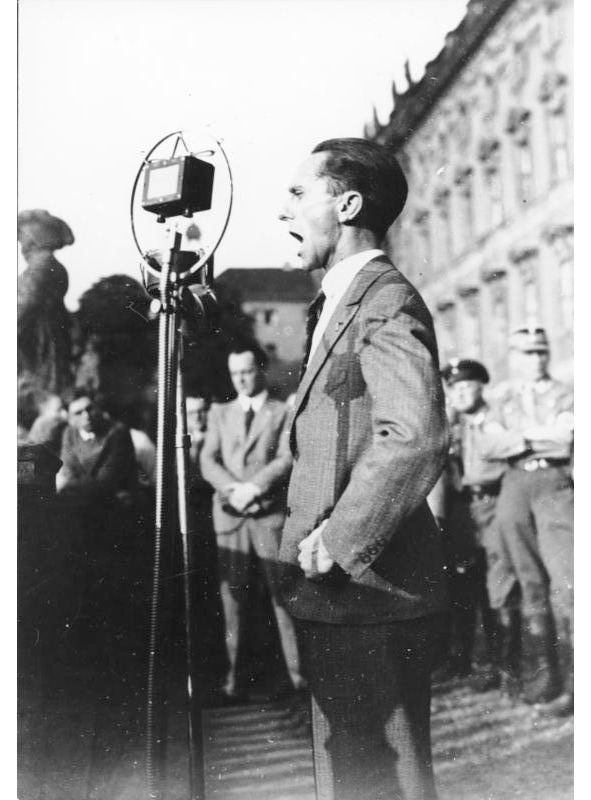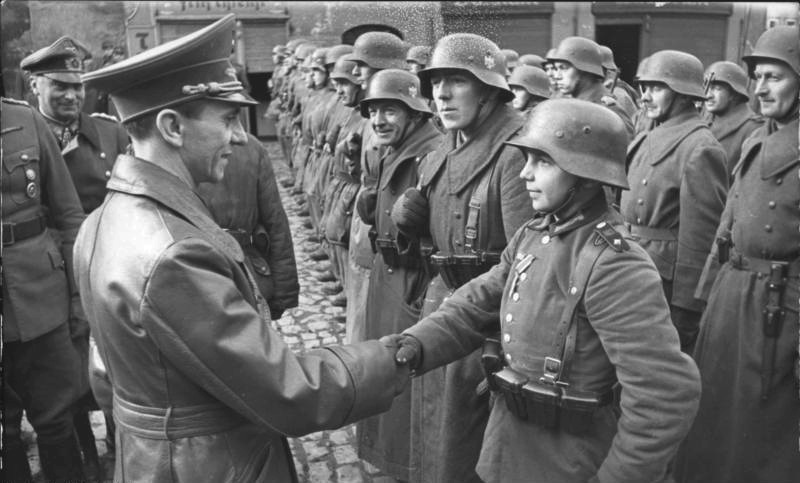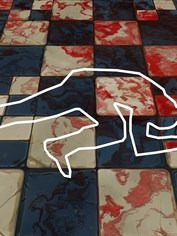
Бесплатный фрагмент - Propaganda Goebbels
Paul Joseph Goebbels. Biography, photo, personal life
“The more monstrous the lie, the more willing the crowd believes in it,” said the ideologist of fascism and the faithful companion and companion of Hitler, the propaganda minister Joseph Goebbels.

The rise and fall of Joseph Goebbels
His talents in skilfully staging speeches before the masses of the people and praising the ideas of the Reich Chancellor of Germany Adolf Hitler, as well as the knowledge of rhetoric Goebbels, showed in 1933—1945 as the minister of the Office of Propaganda of the NSDAP. Prior to this, since 1930, having left the post of Gauleiter of Berlin, Goebbels, being the chief of the propaganda of the Weimar Republic, actively popularized the ideas of the National Socialists at the stage of the completion of the formation of the idea of the Third Reich.
Let us return to 1926 and the activities of Goebbels as Gauleiter of Berlin and Brandenburg. This post was not at that moment enviable, since Berlin was considered an ancestral lands of socialists and communists, and the cell of the NSDAP had only 500 members. But it was in this post that during the numerous campaign rallies and meetings Goebbels honed his oratorical abilities so that in the future he would receive the terrible nickname of the Bloody Romantic of Nazism.
Focusing on the levers of management of modern technology of the time, radio and television, Goebbels, including the president of the Imperial Chamber of Culture, skillfully introduced the idea of the selectivity of the German nation and the need for anti-Semitism and the Holocaust in order to maintain the purity of Germans blood. “Give me the media, and I will make a herd of pigs out of any nation,” Goebbels said.
The result of his active agitation was the November pogrom of 1938, the mass deportation of Jews and their extermination in concentration camps. Goebbels’ speech on the total war to the victorious end in February 1943, when German troops suffered the hardest defeats on all fronts in Europe and Africa, became a vivid example of the use of neo-linguistic programming through appealing to the national self-consciousness of the Germans and manipulating the notions of pride, honor and dignity. During his 109-minute speech, Goebbels was able to create an unimaginable heat of emotions and passions, leaving the podium to lose weight by seven feet.

Tragic shade had a short career of Goebbels — one day he was, according to the will of the Fuhrer, the post of the Reich Chancellor of Germany, replacing on him committed, along with Eva Braun, Hitler’s suicide. In a day, Goebbels followed the lead of the leader, taking poison with his wife and six children. The names of all five daughters and the son of Magda Goebbels, a staunch supporter of the Fuhrer, began in his honor with the letter “H” (from him Hitler). In February 1945, Goebbels invited Magde to leave with the children from Germany, but the devoted wife and fan of the ideas of National Socialism and Hitler flatly refused.
Goebbels’s childhood and youth
The biography of all the members of the Nazi Party on closer examination was not so clean with regard to the Aryan blood, as we would like. Hitler concealed his Jewish roots all his life from grandmother and grandfather, and his fellow Hess, Heydrich, Himmler and Canaris in their “blue blood” had obvious Jewish admixtures. In Goebbels, born in the family of the clerk and later the accountant of the factory of Fritz Goebbels and Maria Katarina Odenhausen, in his youth there were Jewish teachers (for example, literary critic Max Freiherr von Waldberg), and the bride and first love of Elsa Janke was Jewish by mother.
Born on a traditional Catholic family on October 29, 1897, Paul Jozef Goebbels had two elder brothers in the industrial city of Mönchengladbach, Paul Konrad and Hans, and two younger sisters: Elizabeth and Maria (another sister of Goebbels, also called Maria, died in 1896 in infancy). The ancestors of the future minister of propaganda were from the peasants, the roots of his grandmother’s grandmother on the maternal line of Maria Gervers sent any researcher to Luxembourg, but it was her origin that reproached Goebbels with blood purists, hinting at the Jewish kinship of the minister on the Dutch line. Goebbels, in order to dispel all the rumors, was forced to release in 1932 in print material with a detailed description of his family tree.
In his early childhood Joseph Goebbels suffered poliomyelitis, which determined his lameness for life (one of his legs was shorter than the second by 10 centimeters). This defect did not allow him to join the army during the First World War, but later the master of myths and propaganda Goebbels will explain to everyone around his limp injuries received on the battlefields. Josef was ugly and frail since childhood, for which he received from peers the offensive nicknames of Mephistopheles and the Rhine mummy.
Бесплатный фрагмент закончился.
Купите книгу, чтобы продолжить чтение.
